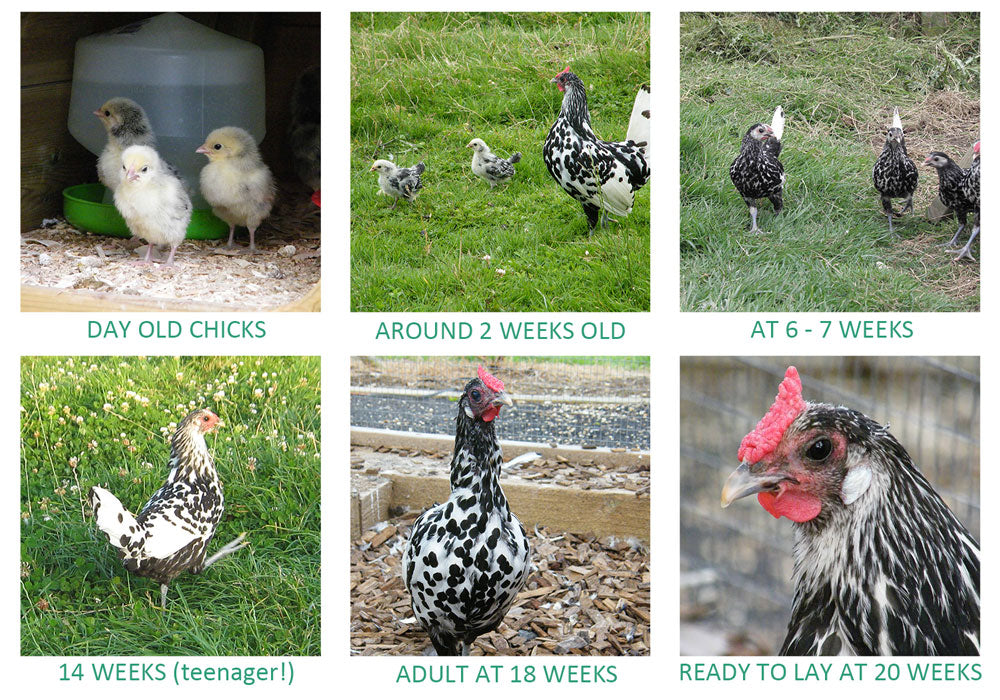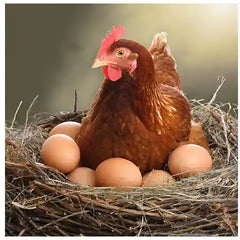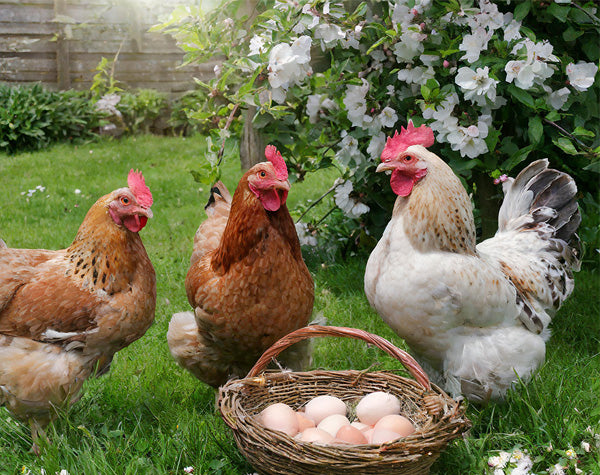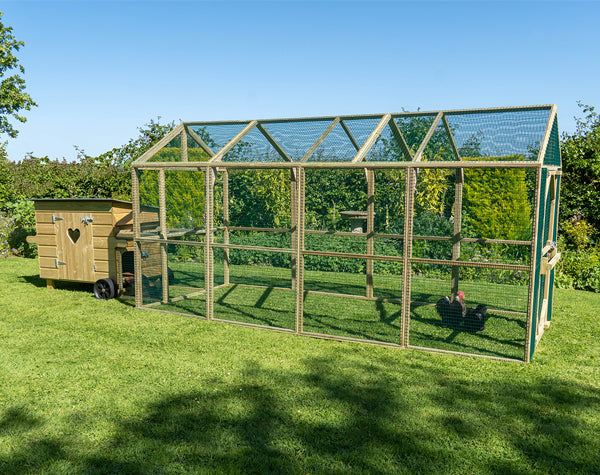The Lifecycle of Laying Hens
Introduction
The humble hen’s egg is a marvel of nature! This simple yet nourishing dietary staple has graced our tables for centuries. Easily prepared in countless ways - from fried to coddled - soft boiled with a full battalion of soldiers to indulgently paired with salmon and hollandaise - and everything in between.

However, behind every egg lies some intricate biology; the story of a hen's laying cycle, and how its journey is influenced by breed, age, and environment.
We'll crack open (excuse the pun) the egg-citing lifecycle of laying hens, from the first eagerly anticipated egg to the sunset years of their laying career.
We have created a graph of egg production over their lifetime, a table listing which breeds are the most prolific layers and the colour of their eggs. We have a collection of photos to show the progression from day-old chicks to egg-layers, details of what influences egg production and answers to some common questions about egg laying.
So, whether you're a chicken hobbyist, a seasoned keeper or simply curious about the wonder of eggs, read on as we show you the egg-laying abilities of the many different hen types and breeds.
Contents:
-
What age do hens start laying eggs?
Hybrids versus Pure Breeds -
How many eggs does a hen lay in a year?
Which breeds lay most eggs and which the least? -
How do you know when a hen is ready to start laying?
How to encourage hen to lay in the nest boxes -
What affects the number of eggs a hen lays?
Seasonality, Breed and Environment -
What is the ideal diet for laying hens?
What laying hens feed should contain - Frequently Asked Questions
What age do hens start laying eggs?
Most hens start laying eggs at around 18 weeks of age, but this does depend on the breed. Hybrid Hens (ISA Brown for example) start at 18 weeks whilst Pure Breeds, like Brahmas, may not start until they are 28 weeks old.
Between hatching and adulthood at 18 weeks, they are too young to produce eggs. From 0 to 8 weeks, they are in the Baby Chick stage, at 8 - 18 weeks (2 - 4.5 months), they are called Pullets (Growers). Once they start laying, the hens tend to be known as ‘Layers’.
Layers usually reach their peak production at about 30 weeks (7 months) and during their first 12 months, they will continue to lay eggs throughout the year, even in winter. After this, egg production starts to slow down by roughly 15% per year. However, the decrease rate can vary depending on the type of bird, the breed, and their environment.
While some hens can live for up to 10 years or more, their most productive period is typically about 2 to 3 years. After this, while they may continue to lay eggs, it will be infrequent and inconsistent. By the time a hen is 5 or 6 years old - depending on breed and type - it is unlikely to be laying any eggs.

Above: Our Silver Spangled Hamburg Bantams from Day Old Chicks to Laying Hens.
Egg Production of Hybrid Hens versus Pure Breeds
Hybrid Hens, usually plain brown crossbreed hens, are bred for egg laying. They start to lay at 18 weeks old and their egg production increases quickly, reaching peak production at about 1 year old, laying close to 1 egg per day. After which there is a gradual decline starting from 2 years of age. These types of hens are commonly used for commercial production in intensive egg farms, but they are a good 'starter' hen.
Pure-Breed Hens, the recognised named breeds, start laying slightly later than hybrids and normally by 24 weeks. Pure-breeds are perhaps more bred for looks as well as for both egg production and as meat birds. Their egg production peaks at around 1.5 years of age, and they have a more sustained production level before starting to decline after 3 years.
The simplified graph below shows the egg production of laying hens, comparing hybrids (in green) to pure breeds (in blue), from birth to 6 years of age.

The graph visually represents how hybrids tend to lay more eggs earlier in their lives but also begin to decline earlier, while pure breeds start laying a bit later, reach a slightly lower peak, and maintain their production longer before declining.
How many eggs does a hen lay in a year?
The egg-laying capability of chickens varies significantly between breeds. Concentrating here on UK breeds, we will look at some of the most prolific egg layers, as well as breeds known for lower egg production.
We have included both Hybrids and Pure-Breeds, and then made an easy-to-read table of the breed names, types, number of eggs per annum and the colour of the eggs.

The most prolific egg layers are Hybrids. The most common of these commercial breeds are Hyline/Goldline Brown, ISA Brown and Warrens. They can lay up to 320-350 eggs per year. They start laying around 18-20 weeks of age and are most productive in their first year of laying.
Similar Hybrids are Lohmann Brown, Black Rock, Amberlink, Calder Ranger, Bluebell and several more that are specific to specialist breeders with their own breed line and names. They are bred for high egg production, with up to 300 eggs per year expected.

The best egg producing among Pure Breeds are the White and Brown Leghorns. A classic choice for high egg production, they can lay around 300 eggs per year and are often used for crossbreeding to produce hybrid hens. They begin laying at about 18 weeks of age and are known for their early and prolific production.
The Light Sussex is a very popular and readily available pure breed in the UK. They start laying at about 20 weeks of age with around 250-270 eggs expected per year. Equally, Rhode Island Reds (Rhodies) are very popular, producing around 200-250 eggs per year.
The lower egg producers are predominantly Bantam breeds and larger pure breeds. Bantams are not a breed on their own but rather, mainly, miniatures of their standard counterparts. Bantams that are true Bantams (with no larger counterpart) include Pekins, Sablepoots, Dutch, Sebrights and Seramas.

Pure Breeds that are kept for their beauty and nature rather than egg laying ability include Cochins – quite large birds with gorgeous, fluffy feathers. They are perhaps more ornamental and lay only 120-150 eggs per year. They tend to start laying at around 22-24 weeks of age but are less consistent in their production.
Also falling into the 120-180 eggs p.a. bracket are Brahmas and Orpingtons. Beautiful and very large but gentle in nature, with a wide variety of colours. They start later than most breeds at around 24-28 weeks of age.
Reference our table below as a guide to the number of eggs expected by breed.
Hen Breeds Egg Laying Table
| Breed Name | Type of Hen | No of Eggs Laid p.a. | Colour of Eggshell | Size of Hen |
|---|---|---|---|---|
| Warren | H | 300-320 | Brown | Medium |
| Hyline Brown | H | 300-320 | Brown | Medium |
| ISA Brown | H | 300-320 | Brown | Medium |
| Lohmann Brown | H | 280-320 | Brown | Medium |
| Black Rock | H | 280-300 | Brown | Medium |
| Leghorns | PB | 280-320 | White | Medium |
| Amberlink | H | 270-320 | Brown | Medium |
| Calder Ranger | H | 270-320 | Brown | Medium |
| Bluebell | H | 260-280 | Brown | Medium |
| Speckledy | H | 250-300 | Brown | Medium |
| Australorp | PB | 250-300 | Brown | Large |
| Sussex | PB | 250-270 | Brown | Large |
| Ancona | PB | 220-240 | White | Medium |
| Rhode Island Red | PB | 200-250 | Brown | Large |
| Plymouth Rock | PB | 200-250 | Brown | Large |
| Marans | PB | 200-250 | Dark Brown | Large |
| Hamburg | PB | 200-250 | White | Medium |
| Wyandotte | PB | 200-240 | Brown | Large |
| Cream Legbar | H | 190-250 | Blue/Green | Medium |
| Buff Orpington | PB | 180-220 | Brown | Large |
| Barnevelder | PB | 180-200 | Dark Brown | Large |
| Welsummer | PB | 160-200 | Dark Brown | Large |
| Araucana | PB | 150-200 | Blue/Green | Medium |
| Dutch Bantam | PB | 150-200 | White | Small |
| Silkie (Bantam) | PB | 100-120 | Cream | Small |
| Pekin Bantam | PB | 100-150 | Cream/Brown | Small |
| Sebright (Bantam) | PB | 60-80 | White | Small |
Notes:
Type of Hen: 'H' denotes hybrid, and 'PB' is for pure breed, including bantams.
No of Eggs Laid p.a.: Sorted by this column with the highest egg producers at the top.
Colour of Eggshell: This is the typical eggshell colour produced by each breed.
Size of Hen: Indicates whether the breed is considered small, medium, or large.
How do you know when a hen is ready to start laying?
A Pullet getting ready to lay her first egg is an eagerly awaited time for chicken keepers. So, if you are a first-timer, here are the clues ...
1. Age: Most hens start between 18 and 24 weeks (depending on breed).
2. Behaviour: Visiting the nest boxes, perhaps sitting in them, and rearranging the bedding to make herself comfortable. Making far more noise than usual and squatting down with wings spread when you approach, which shows she is ready for mating. You may also notice that, as she matures, she will now readily use the perches.

3. Physical: The comb and wattles will redden considerably and grow larger. Some breeds show changes in their feathering around the vent, too. The vent also becomes larger and the space between the pelvic bones widens when she is ready to lay the first egg.
4. Appetite: She will probably eat noticeably more as her body requires more nutrients to produce eggs, particularly calcium. Make sure she has access to oyster shell or calcium supplements.
Watch your young hens closely to look for these changes and make sure they have a balanced diet with plenty of calcium.
To encourage laying, ensure they have cosy nest boxes with a soft bedding material like Chopped Hemp. The best place for nest boxes is on the darkest side of the hen house, so she feels safe and cosy, and they should be positioned lower than the perches (not under the perches) to prevent them from sleeping in the nest boxes. Best practice is to allow one nest box space per 4 to 5 birds (depending on size).
What affects the number of eggs a hen lays?
Many factors can influence both quantity and quality of eggs produced throughout the year. Chief among these is undoubtedly variations in daylight hours, temperature, and autumn moulting.
Seasonality:
 Daylight hours are a critical factor. Hens need approx. 14 to 16 hours of daylight to give them enough Vitamin D to help metabolise calcium in the body, which they need to maintain optimal egg production.
Daylight hours are a critical factor. Hens need approx. 14 to 16 hours of daylight to give them enough Vitamin D to help metabolise calcium in the body, which they need to maintain optimal egg production.
Equally, as with all vertebrates, the pineal gland in chickens regulates the circadian rhythm, which plays a crucial role in egg-laying processes. The pineal gland is affected by light and, indirectly, through the hypothalamus and pituitary gland, controls the release of the hormones that make the ovaries release eggs.
Therefore, longer daylight hours in summer can naturally boost egg production, whereas shorter days in winter lead to reduced egg production. Many poultry keepers, especially commercial egg farms, use artificial lighting to mimic daylight hours and maintain egg production.
Temperature also plays a role as both extremely high and low temperatures can stress the hens. Hens lay best at temperatures between 13°C to 24°C.
During hot weather, egg production can decrease, and egg quality can suffer. Always provide plenty of ventilation within a henhouse overnight and adequate shady places during the day.

In cold and freezing temperatures, it requires more energy to keep warm, so reduces the energy available for egg production. Providing shelter (especially from cold winds) and plenty of bedding in the henhouse, will help keep the hens healthy and increase their ability to lay eggs.
Moulting is a process where they lose old feathers and grow new ones, usually in the Autumn and early Winter. The moult itself, in most cases, lasts approx. 4 – 5 weeks.
During moulting, egg production will probably stop altogether as the bird's energy is focussed on feather regrowth. After moulting, and as daylight hours increase, hens usually return to laying eggs with renewed vigour, and egg quality can improve.
Breed:
This is largely covered above, under 'How many eggs can a hen lay?'. Hybrid hens, which are crossbred to obtain maximum egg production, will be the most robust layers albeit for a shorter lifetime.
It is worth mentioning, however, that some breeds require more love and attention than others to keep them happy e.g. Silkies, Frizzles, Polish – all have delicate or curly plumage needing extra help to keep clean and mite free. Larger breeds with feathered legs will also need extra care to make sure their ground is dry and parasite-free.
See also our page about Choosing your Chickens which is a collection of information and images of many different breeds.
Diet:
We cover the importance of a laying hen’s diet in the next section.
Environment:
It may seem obvious, but making sure the hen house is clean, cosy and of the right size for the number of birds is important for their general health, stress levels, contentment and therefore ensures good egg production.
A clean hen house with plenty of ventilation is necessary to make sure they have nice fresh air to breathe when roosting at night. As birds excrete (all night), which releases ammonia, having meshed ventilation in the upper part of the house, with small gaps at the base to draw fresh air in, is the best idea. A tightly closed house will not only smell awful, and gaseous, but also as the humidity increases it becomes a stressful environment.

Not having the ‘right’ hen house can lead to suffocation in summer or freezing in winter. Plenty of ventilation in summer, but not in a draught, makes for a comfortable night when you’re wearing a feather duvet. So, getting their atmosphere just right is essential.
With the long winter nights, they can spend up to 15 hours roosting in the henhouse, having only four hens in a coop made for thirty means they are not able to keep warm enough. The roosting birds need to perch close to one another to keep warm but don’t have enough body warmth to spare to lose heat into a large house.
Ventilation (no draughts) is still necessary in winter but adding a heat lamp is not always the answer, we don't recommend it. It could add too much heat overnight and the shock of exiting into very cold air can be too much for the birds with potential for heart attack (they don’t control their body heat like we do).
For more hints and tips on creating the right space, choosing your chickens, and the right chicken coop, visit our Information Centre.
What is the ideal diet for laying hens?

For the best egg production and optimal health of your laying hens, a balanced diet that includes suitable levels of protein, calcium, carbohydrate, and other nutrients is required. Here's a guide to the ideal nutritional levels:
- Protein
Generally, laying hens require a staple feed containing approx. 16% to 18% protein e.g. good quality layers pellets. This level supports regular egg production and maintains the hen's health. This can vary depending on the hen's age and breed, for example, high level egg producers like Hybrid Hens may need the higher end of this protein range.
However, too much protein for some breeds can lead to weight gain which then effectively stops them laying. When birds are in the chick stage, they would have a much higher protein level feed to help them grow - a Baby Chick Crumb. Then as they go through the pullet age it reduces slightly with a Growers Pellet, until they start laying when they would need the Layers Pellets.
- Calcium
Laying hens require significantly higher levels of calcium than for non-laying birds due to the need for shell formation. Laying hens should have a diet with about 3.5% to 4.0% calcium. A good quality layers feed should provide this. Giving a separate source of calcium, like oyster shell, allows hens to consume as much as they need.
As mentioned in our previous blog about How a Hen makes an Egg, if she doesn’t have enough calcium (and the daylight to metabolise it), she will take it from her skeleton to form her eggshells.
- Carbohydrate
A laying hen’s diet should include approx. 50%-60% carbohydrates because they play a crucial role as her energy source which in turn will optimise egg production. Primarily these would be provided by grains in a Mixed Corn for Poultry like corn, barley, wheat, and oats.
While they are essential for energy (and provide body warmth in winter), they should be part of a well-rounded diet to prevent too much weight gain but then, as a daily scratch feed, they help prevent boredom too.
- Minerals
Besides protein and calcium, laying hens need a balanced intake of fats, vitamins A, D, E, and B, as well as minerals like phosphorus, potassium, and magnesium. Providing grit (hen flint grit or mixed grit) is important because it aids in the digestion of feed by grinding it in the gizzard.

In short, a laying hens staple feed should contain 16% Protein; 3.5% Calcium; 4% Fibre; 4% Fats; varying levels of carbohydrate (supplemented with mixed corn); plus vitamins and minerals. Feed on an ad lib basis from a feeder.
It's wise to choose a feed specifically formulated for laying hens to ensure they receive the correct balance of nutrients. Always provide plenty of fresh, clean water, which is essential in maintaining health and egg production.
And now for answers to your Frequently Asked Questions ...
How long do hens live?
On average, a well-cared-for hybrid hen might live around 5 to 8 years, while a pure-breed hen could have a lifespan of 10 years or more. There are wide variations of course depending on the specific breed and their care.
Hybrid hens are bred specifically for high egg production. They have notably shorter lifespans compared to pure-breed hens because they are bred to lay an egg a day in a relatively short period. Naturally, this is very taxing on their bodies, especially in commercial settings. Commercial hens are usually culled or rehomed at 2 years old. However, if kept as pets, free ranging in a garden, with good care, hybrid hens can live longer, potentially up to 5 or 6 years.
Pure-breed hens generally have longer lifespans than hybrids, partly because they are not bred to produce an egg every day and therefore have less physiological stress. Pure-breed hens can live from 5 to 10 or even 12 years (under the right conditions). Like hybrids, their lifespan can be extended with a nutritious diet, ample space to roam, and protection from predators and diseases.
Why have my hens stopped laying?
1. Moulting – annually, most hens shed old feathers and grow new ones. This can take from a few weeks to perhaps 2 months. During this time, they will lay very few or no eggs as their energy goes into feather regrowth. It is a good idea to allow them to rest their bodies from the physical stress of egg production for a while.
2. Nutritional deficiencies - lack of essential nutrients, especially calcium. A balanced diet - see above - formulated especially for laying hens will give them everything they need. However, beware, too much carbohydrate and too many treats can make them fat, which will also stop them laying.
3. Lack of daylight - hens need around 14 - 16 hours of 'proper' daylight to produce an egg. Inevitably, this will fall off as days get shorter. Equally, if their coop and run area is dark and too shaded, they will stop laying.
4. Illness and parasites - this can affect their immune system and lead to infections that, in turn will reduce the hen's ability to lay eggs. A poorly hen will often stop laying while her body fights the infection. Parasites, especially worms, also adds stress to their system.
5. Stress - this can be a significant factor affecting their laying cycle. Changes to their environment like adding more hens to the flock, moving to a new coop, overcrowded coop, feather pecking, patrolling predators leading to shock, or frequent loud noises. All can lead their bodies to react to perceived threats.
Taking proactive steps to keep your hens happy and stress-free will maintain good egg production. Observation and good management are the key.
Why are my hens laying funny shaped eggs?
If you find tiny eggs with no yolk (wind eggs) they could be just starting to lay or coming back into lay after the moult. If they are soft-shelled or shell-less it could be for the same reason, or a shortage of calcium in their diet.
Mis-shapen eggs can also occur for the same reasons, but usually, this is due to age. As their bodies get older and worn out, the egg-producing system doesn't quite work as well as it did when they were young and vigorous.
More on this subject can be found in our page, 'All about Eggs'.
How many hens would I need for a family of 4?
A flock of 4 (hybrid) hens, at optimum production, would produce approx 24-28 eggs per week. But lets say they average out at 20 eggs per week (except during the moult), this would allow 3 eggs per person per week and leave 8 eggs for cakes and cooking.
For pure breed hens to produce that number per week - which very much depends on the breed, see table above - your flock would need to be 6 - 8 hens.
What is the World Record for number of eggs laid in a year?
The World Record for number of eggs laid by one hen is currently (as of March 2023) 371 eggs in 364 days. However, we should note that this was under optimum conditions of daylight, nutrition, health and breed.
The record was set by a White Leghorn hen in 1979 in the USA. It was an exceptional number to produce and is not typical of an average commercial hen under standard conditions.
- - -
How many eggs can a hen lay ©Flyte so Fancy 2024. Author: Anne Weymouth (Director, Flyte so Fancy Ltd). Reproduction of part or all of this text and images is only possible with the express permission of Flyte so Fancy Ltd.


